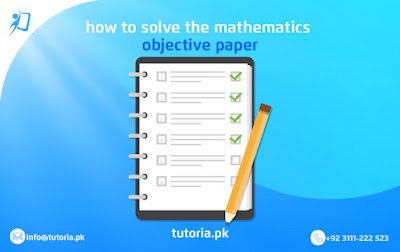Faisalabad Board 10th Class Chemistry Exam Pattern
With the Faisalabad
Board matric exams fast approaching, 10th class students would be wise to get
started on their exam preparation.
In order to effectively
prepare for the Faisalabad Board chemistry final exam, it is important to learn
the paper pattern. This way, you will be able to study more effectively,
according to the time constraints, mark allocation, and types of questions that
appear on the exam.
The best way to prepare
for the 10th class chemistry exam according to the official paper pattern is
with the previous five-year Faisalabad Board 10th class solved past papers. To
give you a headstart on your exam preparation, however, we have broken down the
chemistry exam pattern.
Chemistry
Paper Pattern
In Faisalabad Board, the
10th class chemistry final exam consists of two papers. The first paper is the
objective portion, and the second paper is the subjective component.
Objective Paper
The objective paper
consists of only multiple-choice questions (MCQs). The duration of this portion
is 15 minutes, and the paper carries a total weightage of 12 marks. There are
approximately 12 MCQs in total. Each question has 4 possible solutions, and
students must select the correct answer.
A sample question from
the Faisalabad Board 10th class chemistry past papers 2019, from the objective
type paper, is given below:
- (i) The color of iodine is:
(a)Blue (b) Red (c) Green (d)
Purple
The purpose of the
objective paper is to test your knowledge of the chemistry syllabus. There are
4 possible solutions, which can confuse underprepared students. Therefore, in
order to score maximum marks on this paper, students must thoroughly read and
revise the entire syllabus. Moreover, plenty of past papers practice can help
students overcome any silly mistakes.
Subjective Paper
The second portion of
the Faisalabad Board matric chemistry final exam is the subjective paper. The
total number of marks for the subjective paper is 48. This paper is divided
into two parts.
Short-Answer Questions
The first part consists
of short-answer questions. This part is worth 30 marks in total. Students must
answer 15 short-answer questions in total, with each question carrying 2 marks.
Some sample short-answer questions, taken from the Faisalabad Board 10th class
past papers subjective type paper 2019, are given below:
2. (i) Write two
differences between forward and reverse reaction
3. (ii) What is meant by
carbonization?
4. (i) Write the
composition of dry air
The short-answer
questions are meant to test your knowledge of the chemistry syllabus. Moreover,
it is also a test of your writing ability. Therefore, in order to prepare for
this paper, it is important to thoroughly learn the syllabus, memorize
important definitions and examples, and practice writing. The Faisalabad Board
10th class chemistry solved past papers will be helpful in this regard.
Long-Answer Questions
The second part of the
subjective portion contains long-answer questions. This part carries 18 marks
in total. Students must solve any 2 long-answer questions, which carry 9 marks
each. These are detailed, essay-style questions. Sample long-answer questions
are provided below, taken from the 10th class Faisalabad Board chemistry past
papers subjective type 2019:
5. (a) Define reversible
and irreversible reactions and give examples
6. (b) Write any four
commercial uses of enzymes
7. (b) Give four
properties of water
This is the section that
tests your understanding of the chemistry syllabus. Therefore, it is necessary
to thoroughly learn and understand the syllabus. Rote learning will prove
ineffective for scoring maximum marks in the long-answer questions. Therefore,
for the best exam preparation, understand each chapter thoroughly, along with
relevant examples. Also, use the Faisalabad Board solved past papers to practice
writing long-style questions.
Now that you know the
paper pattern for the matric chemistry exam, you can start preparing
effectively. Be sure to practice solving the different types of questions
equally, in order to score maximum marks.




Comments
Post a Comment